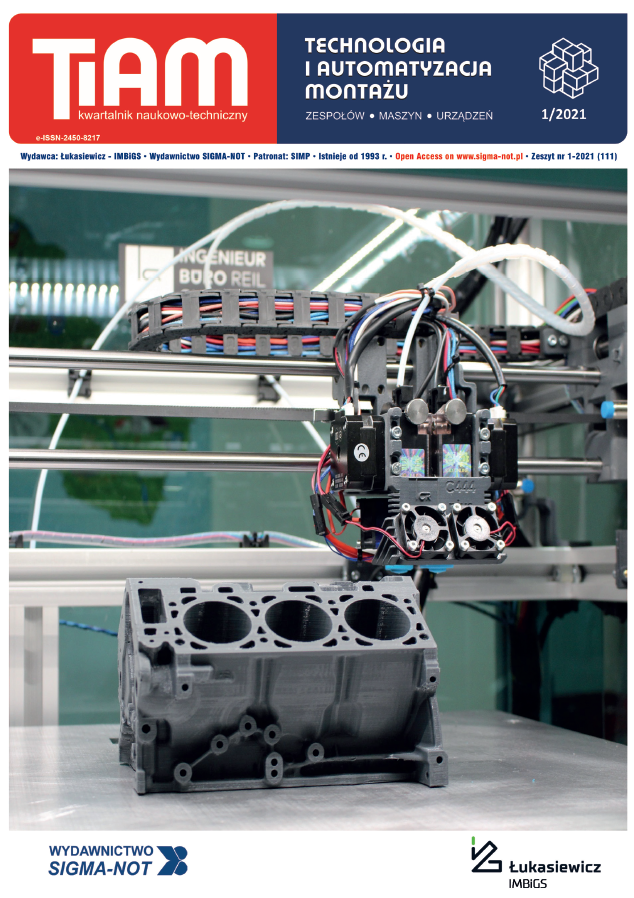Abstract
In integrated manufacturing systems, a very important issue is the problem of ensuring the reliability of cutting tools, in particular high-speed steel broaches. To ensure the required quality of machining, the tool should be changed at specified intervals. Determining the tool replacement period and forecasting the tool's working ability is a difficult and complex issue due to the dispersion of the properties of the tool material and the workpiece. The paper presents the results of research on the dynamics of wear of HS 18-0-1 steel broaches, conducted under production conditions. Based on the analysis of the obtained results, it was shown that the scatter curves of the wear broach teeth VBalong its length and the standard deviation are in the form of a bathtub curve, which indicates uneven work of the broach teeth. In turn the teeth wear variance coefficient can be used to assess the effectiveness of its work. The research also shows that coated broaches are characterized by greater teeth wear stability and double reliable operation.
This is an Open Access article distributed under the terms of the Creative Commons Attribution License CC BY 4.0 (https://creativecommons.org/licenses/by/4.0/)
References
An W., Xu Z., Zhang H. Liu E. 2020. “Experimental study of cutting–parameter and tool life reliability optimization in inconel 625 machining based on wear map approach”. Journal of Manufacturing Processes 53: 34–42.
Artamonov E.V., Vasilega D.S., Ostapenko M.S. 2015. “Methods of considering reliability in the quality evaluation procedure for composite metal cutting tools”. Applied Mechanics and Materials 770: 216–220.
Cai G., Chen X., Li B., Chen B., He Z. 2012. “Operation reliability assessment for cutting tools by applying a proportional covariate model to condition monitoring information’. Sensors 12: 12964–12987.
Courbona C., Arrietab I.M., Cabanettesa F., Rech J., Arrazola P.J. 2020.”The contribution of microstructure and friction in broaching Ferrite–Pearlite steels”. CIRP Annals – Manufacturing Technology 69: 57–60.
Emre Ö, Arash E. A., Erhan B. 2020. “Broaching tool design through force odeling and process simulation”. CIRP Annals – Manufacturing Technology 69, 53–56.
Gaddafeea M., Chinchanikarb S. 2020. “An Experimental Investigation of Cutting Tool Reliability and its Prediction Using Weibull and Gamma Models: A Comparative Assessment”. Materials Today: Proceedings 24: 1478–1487.
Jaworski J., Kluz R., Trzepieciński T. 2016. “Operational tests of wear dynamics of drills made of low–alloy high–speed HS2–5–1 steel”. Maintenance and Reliability 18 (2): 271–277.
Kishawy H. A., Hosseini A., Imani B.M., Astakhov V.P. 2012. “An energy based analysis of broaching operation: Cutting forces and resultant surface integrity”. CIRP Annals – Manufacturing Technology 61 (1): 107–110.
Lauro C. H., Brandao L. C., Baldo D., Reis R. A., Davim J. P. 2014. “Monitoring and processing signal applied in machining processes – A review”. Measurement 58: 73–86.
Legrand C., Fromentin G., Poulachon G., Chatain R., Ranicic M. 2019. “A geometrical and mechanistic generalized model for complex shape broaching of super alloy”. Procedia CIRP 82: 461–466.
Loizou J., Tian W., Robertson J., Camelio J. 2015. “Automated wear characterization for broaching tools based on machine vision systems”. Journal of Manufacturing Systems 37:558–563.
Ortiz–de–Zaratea G., Selaa A., Ducobub F., Saez– de–Buruagaa M., Solera D., Childsc T.H.C., Arrazolaa P.J. 2019. “Evaluation of different flow stress laws coupled with a physical based ductile failure criterion for the odeling of the chip formation process of Ti–6Al–4V under broaching conditions”. Procedia CIRP 82: 65–70.
Pham M. D., Le H. G., Mai D. D., Do T. S. 2020. “An experimental study on the effect of tool geometry on tool wear and surface roughness in hard turning”. Advances in Mechanical Engineering 12(9): 1–11.
Radhakrishnan K., Nirmal Prabhu B., Bharath R. 2020. “Suitability of MC90 Intermet material for optimal design of carbon–free broach tool”. Materials Today: Proceedings 21: 787–792.
Terry W. R., Cutright K. W. 1986. “Computer aided design of a broaching process”. Computers & Industrial Engineering 11(1–4): 576–580.
Teti R., Jemielniak K., O’Donnell G., Dornfeld D. 2010. “Advanced monitoring of machining operations”. CIRP Annals – Manufacturing Technology 59(2): 717–739.
Xu R., Yongfeng Y. 2020. “Effect of Micro–texture of Flank Surface on Broaching Force andSurface Quality of Workpiece”. Applied Surface Science 146558.
Zoriktuev V. T., Nikitin Y. A., Sidorov A. S. 2008. “Monitoring and prediction of cutting–tool wear”. Russian Engineering Research 28(1): 88–91.


